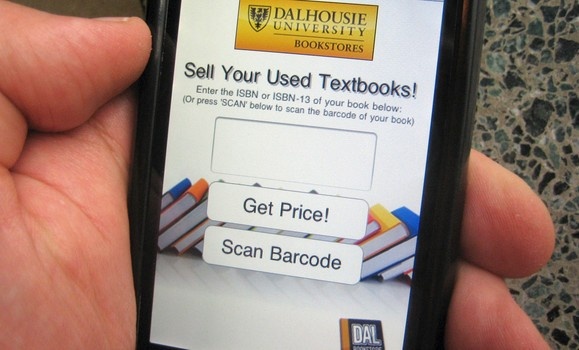Have you ever wanted to know how much you can earn for your old textbook without bringing it in to the Bookstore? Well, now there’s an app for that.
The free mobile app—now available through and the app store—allows students to scan the barcode of their used book with their smart phone to instantly find out the amount the Bookstore will pay for their used textbook. The app also works by typing in the ISBN number found above the book’s bar code.
Tina Shannon, the Bookstore‚Äôs manager, says pilipili¬˛ª≠ is the first university in Atlantic Canada to adopt the new app, which was developed by the company Bookstore 2.0 based out of Kingston, Ont.
“The app is new this year and we jumped on it as soon as it was available,” says Ms. Shannon, adding that the app offers her customers an added level of convenience. “Now, instead of having to bring their old textbooks into the Bookstore when book buybacks are scheduled, they can do it from the comfort of their home. It really is very straightforward and easy-to-use.”
Buyback - December 9-21
The app comes just days before one the Bookstore’s biggest book buyback events of the year. Running from December 9-21, the buyback event is expected to attract hundreds of students who want to turn in their old textbooks from courses that ended after the fall semester. Ms. Shannon explains that four major book buyback events are held every year—at the start and end of each semester—along with a smaller one held every Friday.
She estimates that about $230,000 is paid out to students each year through the book buyback program. And while the Bookstore would like to buy back as many books as possible, Ms. Shannon notes that not all textbooks are eligible for purchase.
“Basically, we won’t accept books that have pages torn out or covers missing, or have signs of any water damage,” Ms. Shannon says. But they don’t have to be in pristine condition, either. “A little bit of highlighting and writing is expected, so we’ll accept those just so long as it’s not too much.”
The amount the used books are worth depends, in large part, if its associated course will be offered again the following semester – if it is, those books can fetch as much as 50 per cent of the original price. The Bookstore also buys books on behalf of an international wholesaler, so even if your textbook can’t be re-sold through the Dal Bookstore, it may still offer money for it if there’s a market for it somewhere else.
In addition to giving students the chance to earn some extra cash, Ms. Shannon points out that the book buyback program has a bigger benefit for the university in its ongoing efforts to becoming a leader in sustainability.
“It’s a great recycling program,” says Ms. Shannon. “It’s just one more way we can help protect the environment.”
Download:
Download:

